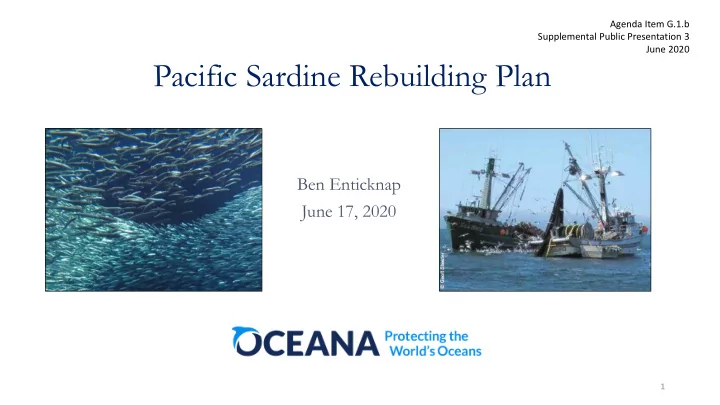

Agenda Item G.1.b Supplemental Public Presentation 3 June 2020 Pacific Sardine Rebuilding Plan Ben Enticknap June 17, 2020 1
Pacific Sardine Have Collapsed 1,800,000 1,600,000 Pacific sardine biomass (age 1 +, metric tons) 1,400,000 1,200,000 1,000,000 AGE 1 + BIOMASS 800,000 FISHERY CUTOFF 600,000 400,000 200,000 0 2005 2006 2007 2008 2009 2010 2011 2012 2013 2014 2015 2016 2017 2018 2019 2020 Data from: Kuriyama et al. 2020. Assessment of the Pacific sardine resource in 2020 for U.S. management in 2020-2021. Pacific Fishery Management Council, Portland, OR. 2
Pacific Sardine are Overfished Pacific sardine biomass (age 1 +, metric tons) 100,000 150,000 200,000 250,000 50,000 0 2013-1 2013-2 2014-1 2014-2 2015-1 2015-2 Calendar Year - Semester 2016-1 2016-2 2017-1 2017-2 2018-1 2018-2 2019-1 CUTOFF MSST 2019-2 2020-1 2020-2 CUTOFF MSST BIOMASS 3
Low recruitment since 2010 Meanwhile MSY exploitation rate is set too high, at 22%, using the CalCOFI temperature index which predicts high sardine recruitment and which is “likely invalid”. Zwolinski and Demer 2019, Available: https://usa.oceana.org/sites/default/files/593/zwolinski _and_demer_-_2019_-_re- evaluation_of_the_environmental_dependence_of_p.pdf Estimated Pacific sardine recruitment (age-0, thousands of fish) (figure ES-2 in the 2020 assessment). Data from: Kuriyama et al. 2020. Assessment of the Pacific sardine resource in 2020 for U.S. management in 2020-2021. Pacific Fishery Management Council, Portland, OR. 4
The Pacific sardine Harvest Control Rule intends low catch rates at low productivity HG = (BIOMASS – CUTOFF) * FRACTION * DISTRUBTION “The harvest control rule for sardine sets the control rule parameter FRACTION equal to F MSY except that FRACTION is never allowed to be higher than 15 percent or lower than 5 percent .” – PFMC CPS FMP* “By the time BIOMASS falls as low as CUTOFF [150,000 mt], the harvest rate is reduced to zero. The CUTOFF provides a buffer of spawning stock that is protected from fishing and available for use in rebuilding if a stock becomes overfished.” *In 2014 the Council revised the FRACTION harvest rate range to 5% -20% but this was never finalized by NMFS in regulation. 5 .
Allowable catch rates are increasing as sardine decline below CUTOFF and MSST Biomass Estimate U.S. Annual Allowable Management (MT) (from Catch Limit U.S. harvest Status Year assessment year) (MT) rate 6.3% Above CUTOFF 2014-15 369,506 23,293 7.2% 2015-16 96,688 7,000 7.5% 2016-17 106,137 8,000 Below CUTOFF 9.2% 2017-18 86,586 8,000 13.4% 2018-19 52,065 7,000 16.4% 2019-20 27,547 4,514 Below MSST 15.2% 2020-21 28,276 4,288 6
Adopt a full range of rebuilding alternatives and management measures • Set the overall U.S. Annual Catch Limit (ACL) equal to 5 percent of estimated stock biomass until the population rebuilds to B MSY . ACL Rebuild = Biomass * 0.05 * Distribution • Continue to prohibit a directed commercial fishery when the sardine population drops below the 150,000 mt CUTOFF. • Set a maximum incidental catch allowance in other directed CPS fisheries at 10% of total landings when below MSST and at 20% when below CUTOFF. 7
The rebuilding plan must update management assumptions and resolve flaws to ensure successful, timely rebuilding • Change the start date of the fishery to January 1 and use the results of the acoustic trawl survey in a timelier fashion as recommended by the STAT team and in past STAR panel reports. • Update the MSST value for Pacific sardine to reflect the best available science as presented in the NMFS 2016 analysis. • Consider modifications to the harvest control rule to prevent future overfishing and reduced impacts on sardine predators: Fix DISTRIBUTION, Increase CUTOFF, use best available science in determining E MSY • Initiate actions to develop a coordinated tri-national approach to sardine research and management 8
Continued fishing pressure on a collapsed population risks delayed rebuilding, preventing full recovery, and impacting the health of the ecosystem “In the 1940s, the larger, migrating sardine were targeted aggressively, the number of cohorts declined, and their seasonal migration stopped. …The harvesting pressure on the residual sardine stock continued off southern California until the early 1960s. Consequently, when the CCE experienced another warm period in the 1980s, the recovery of the northern sardine stock in the CCE apparently was delayed by a decade. By that time, the warm period had begun to wane, and the stock grew to only about one-third of its historical size and remained large for only half as long before declining again in association with the onset of another cold period.” –Zwolinski and Demer 2012. www.pnas.org/cgi/doi/10.1073/pnas.1113806109 9
Summary of Requests • Develop a rebuilding plan - based on the best available science - that prevents further depletion and allows for the rapid and robust recovery of Pacific sardine when environmental conditions shift and this population is once again productive. • Direct the CPSMT to analyze a full range of rebuilding alternatives and management measures, including the alternative proposed in Oceana public comment. • As part of the rebuilding plan, implement management reforms to improve conservation and management of the Pacific sardine fishery based on the best available science . 10
Recommend
More recommend